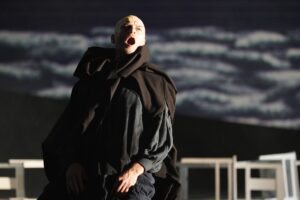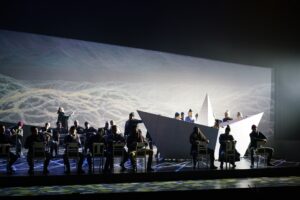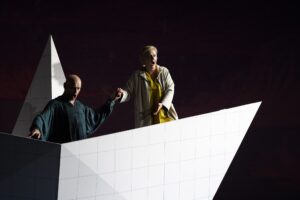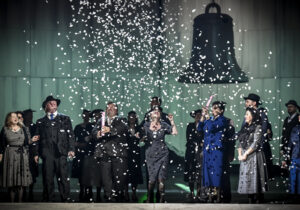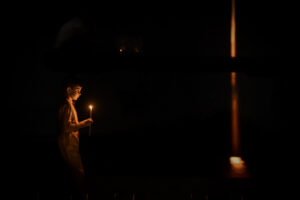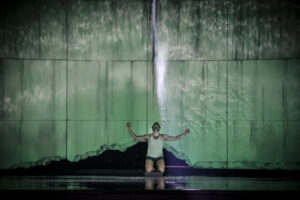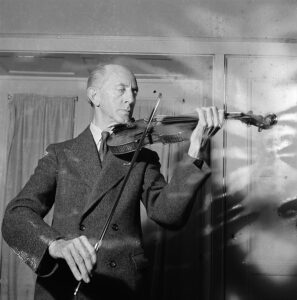Ojciec Fotis, kapłan greckich uchodźców z powieści Kazandzakisa Chrystus ukrzyżowany po raz wtóry, zdrzemnął się kiedyś na chwilę i we śnie krótkim jak błyskawica przeżył co najmniej tysiąc lat. Przyśnił mu się żółty, podobny do kanarka ptak, którego zaczął gonić, kiedy był jeszcze małym chłopcem. Na starość zrozumiał, że będzie za nim gonił aż do śmierci. Poczuł też w głębi duszy, że ten żółty ptaszek, „już to gwiżdżący szyderczo, już to śpiewający w ekstazie z główką wzniesioną ku niebu”, nie był w istocie kanarkiem, tylko potężnym symbolem wiary, nadziei i determinacji.
To Kazandzakis przekonał Martinů, żeby zrezygnował z pomysłu skomponowania opery na motywach Greka Zorby i sięgnął po jego późniejszą powieść-moralitet. Oryginalny tytuł grecki, Ο Χριστός Ξανασταυρώνεται, ma nieco inny wydźwięk niż w polskim przekładzie Jadwigi Dackiewicz. Chodzi o Chrystusa, którego do dziś nie przestano krzyżować, mimo że od Jego śmierci minęły dwa tysiąclecia. Akcja powieści toczy się w roku 1921, podczas wojny grecko-tureckiej, w fikcyjnej wiosce w Anatolii, której mieszkańcy co siedem lat przygotowują uroczyste misterium pasyjne – z udziałem aktorów wybranych spośród członków lokalnej społeczności. Do swych ról tradycyjnie przygotowują się miesiącami: tym razem proces ich utożsamienia z postaciami Nowego Testamentu raptownie przyśpiesza. W wiosce pojawia się tłum wygłodniałych, schorowanych uciekinierów z innej greckiej osady. Wkrótce rozegra się autentyczny dramat męki i śmierci. Wdowa Katerina naprawdę okaże się Marią Magdaleną, jej kochanek Panait – wcielonym Judaszem, Manolios umrze jak biblijny Chrystus.
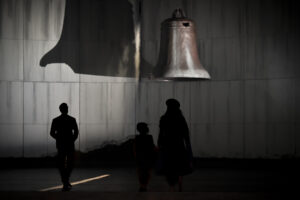
Fot. Marek Olbrzymek
Martinů sam wówczas dochodził do kresu swej drogi krzyżowej. Paryż, w którym spędził prawie dwadzieścia lat, opuścił w 1940 roku, tuż przed zajęciem miasta przez nazistów. Wpierw znalazł schronienie w Akwitanii, u dyrygenta Charlesa Muncha, następnie przedostał się przez Hiszpanię do Portugalii, skąd wyemigrował do Stanów Zjednoczonych. Nigdy się tam nie zadomowił i po wojnie zamierzał wrócić do Czechosłowacji, zwłaszcza że wciąż dochodziły go wieści o tragicznych losach pozostawionych w kraju przyjaciół i krewnych. W roku 1946 uległ niefortunnemu wypadkowi we własnym domu w Massachussets. Wskutek odniesionych obrażeń całkowicie stracił słuch w jednym uchu i nabawił się nieodwracalnych kłopotów z równowagą. Jego plany ostatecznie pokrzyżowało przejęcie władzy w ojczyźnie przez komunistów. Schorowany kompozytor w końcu się poddał i wystąpił o obywatelstwo amerykańskie.
Za pisanie Pasji greckiej wziął się w 1954 roku – tym samym, w którym ukazała się powieść Kazandzakisa. Pracował nad operą trzy lata: ostateczną wersję utworu, z własnym angielskim librettem według przekładu książki, przedłożył menedżerom Royal Opera House w Londynie, gdzie dyrektorem muzycznym był wówczas jego rodak Rafael Kubelik. Mimo przychylnej decyzji zarządu do premiery nie doszło: do odrzucenia wadliwej rzekomo partytury przyczynił się związany z teatrem kompozytor Arthur Bliss. Martinů przeprowadził gruntowną rewizję dzieła, dokonując licznych skrótów, które – paradoksalnie – zburzyły spójność narracji. Prapremiery w Zurychu nie dożył. Zmarł dwa lata wcześniej, w 1959 roku. Osierocona Pasja grecka zawitała wkrótce na sceny czechosłowackie, najpierw do Brna, w roku 1962, potem do Pragi i Bratysławy. Doczekała się też kilku wystawień w innych krajach Europy. Gwałtowny wzrost popularności ostatniej opery Martinů nastąpił w latach osiemdziesiątych, po słynnej inscenizacji w Cardiff pod batutą Sir Charlesa Mackerrasa, który niemal równolegle zarejestrował całość wersji na płytach, z brytyjskimi solistami, chórem Filharmonii Czeskiej i orkiestrą filharmoników z Brna. Na rekonstrukcję wersji pierwotnej, dokonaną pod nadzorem Aleša Březiny, trzeba było zaczekać do roku 1999: „druga” premiera Pasji greckiej odbyła się na Festiwalu w Bregencji. Martinů doświadczył satysfakcji zza grobu: wiosną następnego roku ta sama produkcja weszła na afisz ROH.
Brno pod wieloma względami może uchodzić za czeską kolebkę Pasji greckiej, niekoniecznie jednak w kształcie zamyślanym przez kompozytora. Czesi oswoili się z wersją zuryską, z librettem przetłumaczonym na ich język ojczysty tuż po prapremierze w 1961 roku. Zrekonstruowaną wersję „londyńską” przyjęli z mieszanymi uczuciami, zaskoczeni, że mają do czynienia właściwie z inną operą. Realizatorzy najnowszej inscenizacji w Teatrze Janaczka wybrali drogę pośrednią, czyli wersję z Zurychu z angielskim librettem – co znów wzbudziło pewne kontrowersje, zwłaszcza ze strony orędowników komunikatywności dzieła scenicznego, o tyle uzasadnione, że partie solowe obsadzono prawie bez wyjątku czeskimi śpiewakami. Premiery wyczekiwano jednak niecierpliwie: ze względu na udział Jiříego Heřmana w tym przedsięwzięciu, reżysera, który już w roku 2015, tuż po objęciu dyrekcji artystycznej Opery w Brnie, wystawił Pasję grecką w Aalto-Musiktheater Essen – ze sporym sukcesem, zarówno w oczach krytyki, jak i publiczności. Pandemia wystawiła melomanów na dodatkową próbę cierpliwości. Pasja, planowana pierwotnie na podwójny jubileusz Martinů, trafiła na scenę dopiero w listopadzie 2021 roku. W tym sezonie pojawiła się w Brnie trzykrotnie. Udało mi się dotrzeć na ostatnie przedstawienie.
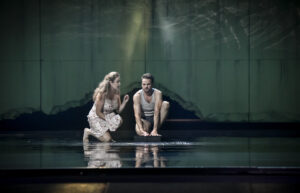
Fot. Marek Olbrzymek
I było warto, choćby po to, żeby znów zachwycić się wizualnym pięknem koncepcji Heřmana (obejmującej także reżyserię świateł), przygotowanej we współpracy ze scenografem Draganem Stojčevskim i projektantką kostiumów Alexandrą Gruskovą. Choć Heřman „przemycił” do spektaklu kilka rozwiązań wypróbowanych w Essen – między innymi zawieszony nad sceną potężny dzwon i las płonących świec na proscenium – brneńska inscenizacja jest znacznie bardziej spójna i nosi więcej znamion specyficznego stylu reżysera. Kolorystyka jak zwykle waha się między przepastną czernią, złamanymi tonami błękitu a nieoczywistą żółcienią: ta ostatnia odgrywa skądinąd najdonioślejszą rolę w tym przedstawieniu, poprzedzonym obszernym cytatem z przytoczonego powyżej snu ojca Fotisa. Żółty jest ogień paschalnych świec, na żółto ubrany jest zarówno chłopiec uganiający się za podobnym do kanarka ptakiem, jak i Manolios, przygotowujący się do roli Chrystusa. Czarna jest noc hipokryzji i ciemnoty, ucieleśniona w postawie popa Grigorisa, który przekonywał wioskową wspólnotę, że jeśli niesprawiedliwość wyrządzona jednostce przynosi korzyść masie, to wówczas jest słuszna. Błękitne – choć czasem na granicy szarości, innym zaś razem przechodzące w zieleń – jest wszystko to, co nieoczywiste. Między innymi drzewa rosnące koroną w dół, wczepione korzeniami w fundamenty domów, jakby się bały wystrzelić pędami na zewnątrz, w świat dzielony przez Greków na czasy przed i po wielkim pożarze Smyrny, który ostatecznie przypieczętował klęskę ich armii w 1922 roku i pogrzebał w pyle rojenia o aneksji Azji Mniejszej. Znakiem wolności, wiary i nadziei jest życiodajna woda, po której Manolios chodzi jak Chrystus – podziwu godne, z jaką maestrią Heřman wykorzystuje ten prosty chwyt teatralny w większości swoich przedstawień, zwielokrotniając migotliwą postać wody w lustrzanych projekcjach w tle sceny.
Inscenizacja Heřmana jest głęboko symboliczna, podobnie jak opera Martinů, w której kompozytor zostawił mniej miejsca na grę charakterów niż na ogólną przypowieść o mocy dobra i zła, pozbawioną obecnych w powieści Kazandzakisa odniesień historycznych i politycznych. Heřman postanowił przedstawić Pasję grecką jako historię uniwersalną, osadzoną w niejasnym kontekście, wolną od aktualnych aluzji. W pełni rozumiem jego decyzję, zwłaszcza że w świetle najnowszych wydarzeń nieszczęśni uchodźcy pod wodzą ojca Fotisa przywodziliby raczej na myśl Rosjan uciekających z Krymu. Chrystus ukrzyżowany po raz wtóry to poniekąd narracja o tragedii najeźdźców, dojmująca parabola losu prostych ludzi uwikłanych w konflikt rozgrywający się ponad ich głowami. Trochę mi jednak szkoda, że Heřman poprzestał na reżyserowaniu tłumów, operowaniu metaforą, nie wgłębiając się w motywację poszczególnych postaci dramatu, pozostawionych samym sobie, na pastwę własnych możliwości wokalnych i aktorskich. Trochę mnie dziwi optymizm reżysera, który dostrzegł promień nadziei tam, gdzie go nie było: ani w partyturze, ani w ostatnim zdaniu książki Kazandzakisa, gdzie sponiewierana wspólnota pod wodzą Fotisa zaczęła „iść ku wschodowi drogą bez końca”.
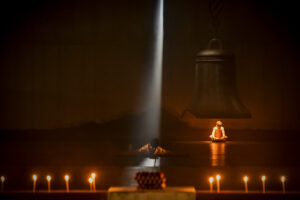
Fot. Marek Olbrzymek
Myślę, że nieposkromiona wyobraźnia Heřmana zyskałaby dużo szersze pole do popisu w wersji pierwotnej, bardziej teatralnej, kipiącej od emocji, naznaczonej raptownymi zmianami nastroju. Narracja zuryska dramaturgicznie kuleje, sprawia wrażenie kalejdoskopowej, nie pozwala odbiorcy utożsamić się w pełni z żadną z postaci. Nie poradził sobie z tym paradoksem Robert Kružík, prowadzący Pasję grecką dość ciężką ręką, masywnym dźwiękiem, podkreślając rzekomy monumentalizm tej partytury, której w gruncie rzeczy całkiem blisko do późnych oper Brittena. Celnie uwypuklił surowość greckich śpiewów prawosławnych, docenił wyrafinowaną stylizację melodii ludowej na początku III aktu oraz wiejskiej muzyki weselnej, po drodze jednak zgubił napięcie i przejmujący liryzm stylu późnego Martinů, zatrzaśniętego w tęsknocie do ojczyzny, do której przyszło mu nigdy nie wrócić. Nie wskazał odpowiedniej drogi solistom, którzy w większości stworzyli dość płaskie, jednowymiarowe postacie. Nie tchnął żaru w przemianę Manoliosa, którego partię realizował poprawnie, lecz bez większego zaangażowania Peter Berger. Zlekceważył zmysłowość Kateriny w ujęciu obdarzonej miękkim i kolorowym sopranem Pavli Vykopalovej. Nie zróżnicował łotrów i sprawiedliwych, przez co głosem pewniejszym i bardziej zapadającym w pamięć przemówił ojciec Grigoris w ujęciu Jana Šťávy niż realizujący partię Fotisa – być może ważniejszą w operze od głosu Manoliosa – młody morawski bas-baryton David Szendiuch. Kto wie, czy nie najgłębiej zapadł mi w pamięć fenomenalny Ondřej Koplík w tenorowej partii domokrążcy Jannakosa, wcielającego się w rolę Piotra, najważniejszego z apostołów – tego, który nie przyznał się wobec ludzi do znajomości z Chrystusem.
Wszystko to jednak nie zmieni faktu, że Pasja grecka – przeszło sześćdziesiąt lat od prapremiery – wzbudza struny głuche dla wielu odbiorców treści z pierwszych stron serwisów internetowych. Uzmysławia gorzką prawdę o tragedii wszystkich wypędzonych, choćby ich przywódcy stali po niewłaściwej stronie. Tłumaczy, że szatan może wejść tylko do piekła, anioł może wejść tylko do raju, człowiek zaś może wybierać. Mimo wszystko daje nadzieję, że człowiek kiedyś wreszcie dokona właściwego wyboru.




